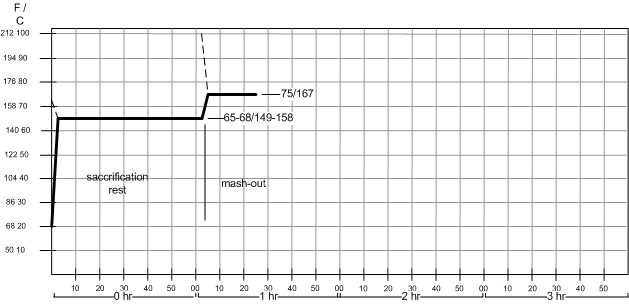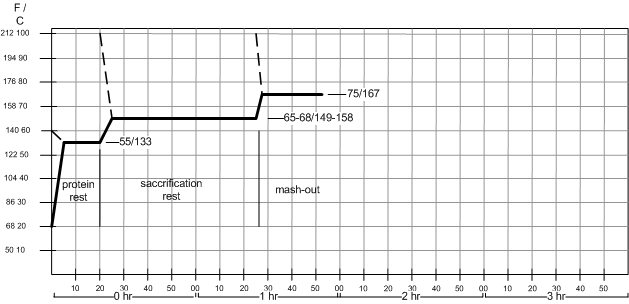Infusion Mashing
Infusion mashing is the process of achieving the rest temperatures either by adding measured amounts of water heated to carefully calculated temperatures to the mash or using direct heat to heat the mash.
In a single infusion mash, the mash water is added all at once and the mash is held at a single steady temperature for the entire mash. In a step infusion mash, some of the water is held back and heated to a carefully calculated temperature before being added to the main mash to raise the temperature to each additional step. In either case, an insulated mash tun, such as a converted picnic cooler mash tun, is used to keep the temperature steady without the need for direct heat. A step infusion mash can also be accomplished with direct heat.
Single temperature infusion mash
The single infusion mash uses a single temperature rest at which the beta and alpha amylase enzymes are active to convert the malt starches into wort sugars. The rest temperature controls how long the beta amylase will be active and though that the amount of fermentable sugars that are produced. The higher the mash temperature is, the lower the limit of attenuation of the resulting wort will be. This is the most common mash schedule among home brewers and craft brewers because it is well suited for American and British 2-row malts which are generally highly modified and don't benefit from a lower temperature rests. It is also well suited for the use of unheated mash tuns (e.g. coolers) which are the preferred mash vessel among most home brewers. The rest temperatures are commonly between 149 *F (65 *C) and 165 *F (69 *C). Many brewers like to use 152-154 *F (66.5-67.5*C) as their preferred mash temp as it gives a nice balance of body and fermentability that works well for British and American style ales.
In order to do a single infusion mash, the strike water (water used for the mash) is heated to a certain temperature such that when the grains are mixed in, the resulting temperature is the desired rest temperature. The temperature of the strike water can be calculated with the following formula [Palmer, 2006]:
Strike Water Temperature Tw = (.2/R)(T2 - T1) + T2
- R = Ratio of water to grain in quarts per pound
- T1 = the temperature of the grains in Fahrenheit (or Celsius)
- T2 = the target temperature of the mash in Fahrenheit (or Celsius)
- Note: Palmer writes that R can be expressed as quarts per pound or liters per kilogram. This is not correct since 1 l/kg is approximately 0.5 qt/lb. This needs to be accounted for when using metric units in the above formula. The temperature however can be used as Fahrenheit or Celsius as long as all temperature values use the same unit or measure.
Hitting the mash temperature is for many brewers the biggest problem when doing a single infusion mash. This can some times lead to frustration. The reason for that is, that the above formula doesn't account for heat loss to the mash tun. It basically assumes that the mash tun has a thermal capacity of 0. To get around this one can preheat the mash tun with some boiling water or adjust the strike water temperature based on the results in previous mashes. If the latter is used the brewer should keep the mash tun and grain temperature constant between the different mashes. Another way to eliminate the unknown factor of the mash tun's thermal mass is to adjust the strike water's temperature after it has been added to the mash tun and before the grains are added. This can be done with hot and cold water.
When mashing in at or above the gelatinization temperature of barley starch (between 140 and 150 *F / 60-65 *C) the grains should be added to the strike water rather than the strike water to the grains. This minimizes the formation of dough balls. Such dough balls form when the starch around them gelatenizes which provides a barrier for mash water. If they are not broken up during dough in, they can later release unconverted starches into the mash.
With today's highly modified and thus enzymatic strong malts, the mash is generally converted after 15-30 min based on the rest temperature. Lower temperatures mashes convert slower than higher temp mashes of the same grist (see The Theory of Mashing for further details). Most brewers do however mash 60-90 minutes to ensure complete conversion and for the time it gives them to heat the sparge water for example. It is always a good practice to check for conversion of the mash with an iodine test.
To do an iodine test you need a white plate, small spoon and iodine/starch test solution (some home brew stores sell iodine test strips, but they are for testing an iodine solution not for testing for starch). Stir the mash a part ofd the mash a little and take a small sample onto the plate with the spoon. Now drip a few drops of iodine solutions onto that sample. If there are still unconverted starches in the mash, the sample will turn black or dark purple. The mash is converted when you don't see that happening. At this point the wort should also taste sweet. Discard the sample as iodine is toxic.
Though this is considered a single temperature step mash, a mash-out rest can be added. Using hot water infusions (or even decoction as shown later) the mash temperature is raised to 167 *F (75 *C). No harm is done if that temperature is not reached exactly. It should however not be exceeded. Many brewers believe that the purpose of this rest is to stop the enzymatic activity, but that is usually not the case as the alpha amylase is not fully deactivated until 176 *F (80 *C). The prupose of the mash-out is to aid lautering as hotter wort will flow more easily while still allowing enzymatic activity to convert any starches that might be unlocked during lautering [Narziss, 2005]. While this is of a lesser concern for the homebrewer, a mash-out is still a good practice.
Multi step infusion mashes
Multi step infusion mashes refer to mashes with more than one temperature rest not counting the mash-out rest. From one step to the next the temperature is generally increased by the use of heat (direct or indiect), hot water infusions or both. There are various mash rests that can be of interest for the brewer:
- acid rest: for enzymatic mash acidification and no-rush mash pH treatment. Since no significant conversion processes take place at this temperature there is no concern having the mash rest at this temperature for an extended amount of time.
- ferulic acid rest: This is a little different from the regular acid rest as this rest is primarily for the generation of ferulic acid which wheat beer yeasts convert to 4VG, the phenolic character of Bavarian Wheat beers.
- protein rest: This is actually the first additional mash rest that comes to mind when multi step mashes are discussed. The temperature and extend of this rest depends on the degree of modification of the malt. Rest temperatures closer to 122 *F (50 *F) emphazize the generation of short length proteins (amino acids) and temperatures closer to 133 *F (55 *C) result in more medium chained proteins (good for head retention and body). Well modified modern malts, which already have higher levels of amino acids, benefit from a protein rest closer to 133*F (55 *C)
- saccharification rest: This can be done as a single saccharification rest like it is used for single infusion mashes or multiple rests which emphazise beta and alpha amylase speraratly. The latter can result in better fermentability of the wort since it tries to get the most out of the beta amylase.
When direct heat is used to increase the mash temperature between the rests, the temperature should only rise 2-4 *F (1-2 *C) per minute.
The following is an example of a 2 step infusion mash that works well with moderately well modified German malts:
It employs a short protein rest at 133 *F (55*C) and a single saccharification rest. The temperature is increased by the use of boiling water. To run as mash schedule like this, calculate the strike water temperature for your grain, a grist/water ratio of 1.25 qts/lb (~2.5 L/kg) and a rest temperature of 129-133 *F (53-55 *F). Add the water to the grain. Since the dough in happens below the gelattinization temperature of barley starch it is safe to add the water to the grain since there won't be any dough balls. There is also nothing wrong with adding the grain to the water, but it might be convienient to mill the grain directly into the mash tun. The temperature should stabilize somewhere between 122 and 133 *F (50-55 *C). If it is to close to 50, don't worry, just shorten the length of the protein rest or add some boiling water to raise the mash temp closer to 55*F. This assumes that you use fairly well modified (not overmodified) modern lager malts. Use this rest to measure and adjust the pH of the mash if you are set up to do that. The later addition of more water will not have any significant affect on this pH. While the mash is resting at the protein rest bring about 60-70% of the amount of water that you used as strike water to a boil. When the protein rest is over use a heat resistant vessel to soop some boiling water into the mash and stir to mix it in well. Measure the temperature and repeat the process untill you hit the desired saccharification rest temp. This rest temp will depend on the desired attenuation of the wort and you will have to find the optimal temperature by experimenting. As a start you can use the temp that you would use for a single infusion mash. But due to the lower temperaure rest and limited beta amylase and limit dextrinase activity during that rest, the resulting wort fermentability will be higher compared to a single infusion mash at the same saccharification rest temperature.
You could also use this formula to calculate the amount of water that needs to be added to raise the mash temperature [Palmer, 2006]:
Wa = (T2 - T1)(0.2G + Wm)/(Tw - T2)
- Wa = The amount of infusion water added
- Wm = The total amount of water in the mash
- T1 = The initial mash temperature
- T2 = The target mash temperature
- Tw = the actual temperature of the infusion water
- G = The amount of grain in the mash
But the addition of boiling water until the new rest temp is reached is more reliable as it can account for factors that the above formula can't. And since the resulting mash will be quite thin, stiring it and getting the heat evenly distributed for a reliable mash temp reading is not as difficult as it is in a ticker single infusion mash.
Some brewers are concerned that a thinner mash leads to more tannin extraction, but quite the opposite is true. German brewers prefer thinner mashes for delicate and lighter colored beers as it will prduce more of the desirable first wort and since less sparge water has to be used, less tannins are extracted during lautering. This however is only a concern for fly sparing.
The enzymatic activity also benefits from the changing mash thickness. A thicker mash during the protein rest enhances the protoelytic activity and a tinner mash during the saccharification rest enhances the amylase activity.
If there is room left in the mash tun, mash-out can also be reached though another infusion with boiling water or through a decoction. But that will be covered later.




